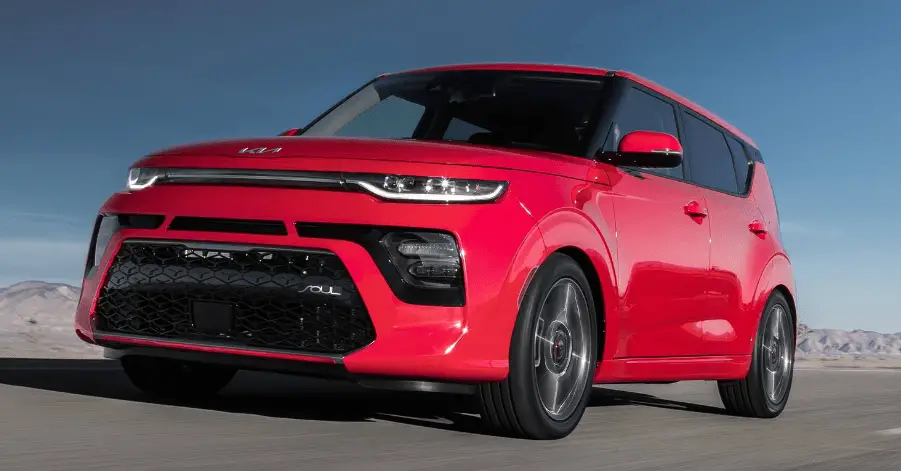Kia Soul 2022 Dual Clutch Transmission (DCT) User Manual
Introduction
The way we drive and interact with vehicles is changing as a result of technological breakthroughs in the automotive sector. The dual-clutch gearbox (DCT) is one such innovation that has grown significantly in popularity in recent years. DCTs have gained popularity among both regular drivers and automobile enthusiasts due to their seamless integration of manual control and automatic ease. In keeping with this development, renowned automaker Kia Motors has added a dual-clutch gearbox technology to its enduring tiny crossover, the Kia Soul, for the 2023 model year. Additionally, the Kia Soul 2023 puts convenience first thanks to its DCT. Drivers of the Soul can continue to benefit from automated driving on daily commutes or in congested areas because the automatic gearbox is still functional in the vehicle. The dual-clutch gearbox in the Soul may, however, be manually operated using paddle shifters located on the steering wheel for those looking for a more hands-on experience. By giving the driver choice over gear changes, this element fosters a sense of involvement and customization.
Kia Soul 2022’s dual-clutch gearbox debut marks a significant development in the development of this adored compact crossover. With the addition of this cutting-edge gearbox technology, Kia Motors has improved the performance, economy, and driving experience of the Soul. The dual-clutch gearbox in the Kia Soul 2023 is ready to deliver, rewriting the norms for compact crossovers and securing the Soul’s position as a trendsetter in the automotive industry, whether you prioritize fuel efficiency, dynamic performance, or a seamless blend of both.
Dual Clutch Transmission (DCT)
The dual-clutch transmission has 7 forward speeds and one reverse speed.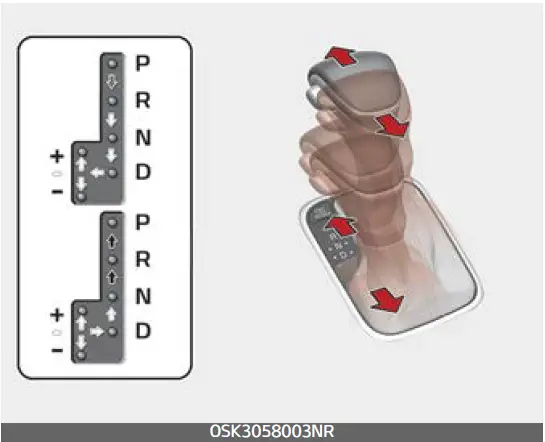
- Depress the brake pedal and the lock release button when shifting.
- Press the lock release button when shifting.
- The shift lever can be shifted freely.
To move the shift lever from/to P (Parking) or between R (Reverse) and D (Drive), you must depress the brake pedal for the vehicle to stand still.
Dual clutch transmission operation
The individual speeds are selected automatically in the D (Drive) position.
WARNING
To reduce the risk of serious injury or death:
- ALWAYS check the surrounding areas near your vehicle for peo-ple, especially children, before shifting a vehicle into D (Drive) or R (Reverse).
- Before leaving the driver’s seat, always make sure the shift lever is in the P (Park) position, then set the parking brake, and place the ignition switch in the LOCK/OFF position. Unexpected and sudden vehicle movement can occur if these precautions are not followed.
- When using Manual Shift Mode, use caution when shifting from a higher gear to a lower gear on slippery roads. This could cause the tires to slip and may result in an accident.
CAUTION
- To avoid damage to your transmission, do not try to accelerate with the shift lever in R (Reverse) or any forward gear position with the brake engaged.
- When stopped on a slope, do not hold the vehicle with the accelerator pedal. Engage the service brake or the parking brake.
- The Dual Clutch Transmission gives the driving feel of a manual transmission, yet provides the ease of a fully automatic transmission. Unlike a traditional automatic transmission, the gear shifting can be felt (and heard) on the dual-clutch transmission.
- Think of it as an automatically shifting manual transmission.
- Shift into the Drive range and get fully automatic shifting, similar to a conventional automatic transmission.
- Dual clutch transmission adopts dry-type dual-clutch, which is different from the torque converter of automatic transmission and shows better acceleration performance during driving. But, the initial launch might be a little bit slower than Automatic Transmission.
- The dry-type clutch transfers torque and provides a direct driving feeling which may feel different from a conventional automatic transmission with a torque converter. This may be more noticeable when starting from a stop or low vehicle speed.
- When rapidly accelerating at low vehicle speed, the engine could rev at high rpm depending on the vehicle’s drive condition.
- For a smooth launch uphill, press down the accelerator pedal smoothly depending on the current conditions.
- If you release your foot from the accelerator pedal at low vehicle speed, you may feel a strong engine brake, which is similar to a manual transmission.
- When driving downhill, you may use Sports Mode to downshift to a lower gear in order to control your speed without using the brake pedal excessively.
- When you turn the engine on and off, you may hear clicking sounds as the system goes through a self-test. This is a normal sound for the Dual Clutch Transmission.
- Always come to a complete stop before shifting into D (Drive) or R (Reverse).
- Do not put the shift lever in N (Neutral) while driving.
CAUTION
Due to transmission failure, the vehicle may not move and the position indicator (D, R) will blink on the cluster. In this case, have the system checked by an authorized Kia dealer.
LCD display for warning message
A warning message is displayed on the LCD when the transmission is over-heated or in a warning condition.
DCT warning messages
This warning message is displayed when the vehicle is driven slowly on a grade and the vehicle detects that the brake pedal is not applied.
Steep grade
Driving up hills or on steep grades:
- To hold the vehicle on an incline use the foot brake or the parking brake.
- When in stop-and-go traffic on an incline, keep some distance ahead before moving the vehicle forward. Then hold the vehicle on the incline with the foot brake.
- If the vehicle is held on a hill by applying the accelerator pedal or by creeping with brake pedal disengaged, the clutch and transmission may overheat which can result in damage. At this time, a warning message will appear on the LCD display.
- If the LCD warning is active, the foot brake must be applied.
- Ignoring the warnings can lead to damage to the transmission.
Transmission High Temperature
- Under certain conditions, such as repeated stop-and-go launches on steep grades, sudden take off or acceleration, or other harsh driving conditions, the transmis-sion clutch temperatures will increase excessively. Finally the clutch in transmission could be overheated.
- When the clutch is overheated, the safe protection mode engages and the gear position indicator on the cluster blinks with a chime. At this time, the “Trans-mission temp. is high! Stop safely” warning message will appear on the LCD display and driving may not be smooth.
- If this occurs, pull over to a safe location, stop the vehicle with the engine running, apply the brakes and shift the vehicle to P (Park), and allow the transmission to cool.
- If you ignore this warning, the driving condition may become worse. You may experience abrupt shifts, frequent shifts, or jerkiness. To return to normal driving condition, stop the vehicle and apply the foot brake or shift into P (Park).
- Then allow the transmission to cool for a few minutes with engine on, before driving off.
- When possible, drive the vehicle smoothly.
Transmission Overheated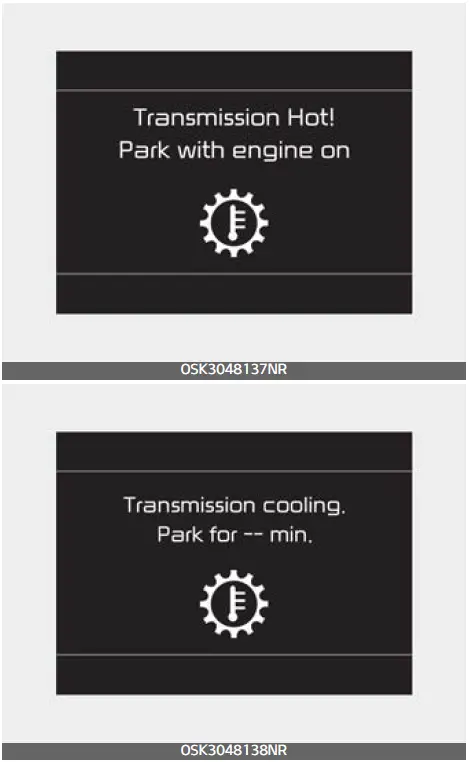

- If the vehicle continues to be driven and the clutch temperatures reach the maximum temperature limit, the “Transmission Hot! Park with the engine on” warning will be displayed. When this occurs the clutch is disabled until the clutch cools to normal temperature.
- The warning will display a time to wait for the transmission to cool.
- If this occurs, pull over to a safe location, stop the vehicle with the engine running, apply the brakes and shift the vehicle to P (Park), and allow the transmission to cool.
- When the message “Trans cooled. Resume driving.” appears you can continue to drive your vehicle.
- When possible, drive the vehicle smoothly.
If any of the warning messages in the LCD display continue to blink, for your safety, have the system checked by an authorized Kia dealer.
Transmission Ranges
The indicator in the instrument cluster displays the shift lever position when the ignition switch is in the ON position.
P (Park)
Always come to a complete stop before shifting into P (Park).
To shift from P (Park), you must depress firmly on the brake pedal and make sure your foot is off the accelerator pedal.
The shift lever must be in P (Park) before turning the engine off.
WARNING
- Shifting into P (Park) while the vehicle is in motion may cause you to lose control of the vehicle.
- After the vehicle has stopped, always make sure the shift lever is in P (Park), apply the parking brake, and turn the engine off.
- Do not use the P (Park) position in place of the parking brake.
R (Reverse)
Use this position to drive the vehicle backward.
CAUTION
Always come to a complete stop before shifting into or out of R (Reverse); you may damage the transmission if you shift into R (Reverse) while the vehicle is in motion.
N (Neutral)
The wheels and transmission are not engaged.
WARNING
Do not shift into gear unless your foot is firmly on the brake pedal. Shifting into gear when the engine is running at high speed can cause the vehicle to move very rapidly. You could lose control of the vehicle and hit people or objects. Do not drive with the shift lever in N (Neutral).
The engine brake will not work and lead to an accident.
CAUTION
Always park the vehicle in P (Park) for safety and engage the parking brake.
D (Drive)
This is the normal driving position. The transmission will automatically shift through a 7-gear sequence, providing the best fuel economy and power.
For extra power when passing another vehicle or driving uphill depress the accelerator pedal further until you feel the transmission downshift to a lower gear.
To stop the vehicle during driving, please press the brake pedal fully to prevent unintended movement.
Manual Mode
 Whether the vehicle is stationary or in motion, manual mode is selected by pushing the shift lever from the D (Drive) position into the manual gate.
Whether the vehicle is stationary or in motion, manual mode is selected by pushing the shift lever from the D (Drive) position into the manual gate.
To return to D (Drive) range opera-tion, push the shift lever back into the main gate. In manual mode, moving the shift lever backward and forwards will allow you to select the desired range of gears for the current driv-ing conditions.
- + (Up): Push the lever forward once to shift up one gear.
- – (Down): Pull the lever backward once to shift down one gear.
NOTICE
- Only the 7 forward gears can be selected. To reverse or park the vehicle, move the shift lever to the R (Reverse) or P (Park) position as required.
- Downshifts are made automatically when the vehicle slows down. When the vehicle stops, 1st gear is automatically selected.
- When the engine rpm approaches the red zone the transmission will upshift automatically.
- If the driver presses the lever to + (Up) or – (Down) position, the transmission may not make the requested gear change if the next gear is outside of the allowable engine rpm range. The driver must execute upshifts in accordance with road conditions, taking care to keep the engine rpms below the red zone.
Paddle Shifter (If Equipped)
The paddle shift function is available when the shift lever is in the D (Drive) position or the manual mode.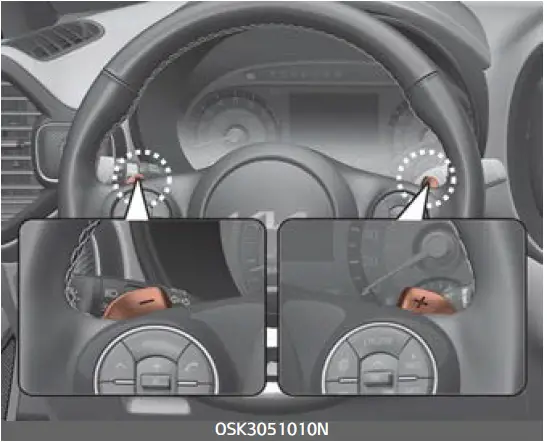
With the shift lever in the D position
The paddle shift function will operate when the vehicle speed is more than 6 mph (10 km/h). Pull the [+] or [-] paddle shifter once to shift up or down one gear and the system changes from automatic mode to manual mode. When the vehicle speed is lower than 6 mph (10 km/h), if you depress the accelerator pedal for more than 5 seconds or if you shift the shift lever from D (Drive) to manual mode and shift it from manual mode to D (Drive) again, the system changes from manual mode to automatic mode.
With the shift lever in the manual mode
Pull the [+] or [-] paddle shifter once to shift up or down one gear.
NOTICE
If you pull the [+] and [-] paddle shifters at the same time, you cannot shift the gear.
Shift lock system
For your safety, the Dual clutch transmission has a shift lock system that prevents shifting the trans-mission from P (Park) into R
(Reverse) unless the brake pedal is depressed.
To shift the transmission from P (Park) into R (Reverse):
- Depress and hold the brake pedal.
- Start the engine or turn the ignition switch to the ON position.
- Move the shift lever.
If the brake pedal is repeatedly depressed and released with the shift lever in the P (Park) position, a chattering noise & vibration near the shift lever may be heard. This is a normal condition.
WARNING
Always fully depress the brake pedal before and while shifting out of the P (Park) position into another position to avoid inadvertent motion of the vehicle which could injure per-sons in or around the car.
Shift-Lock Override
Type A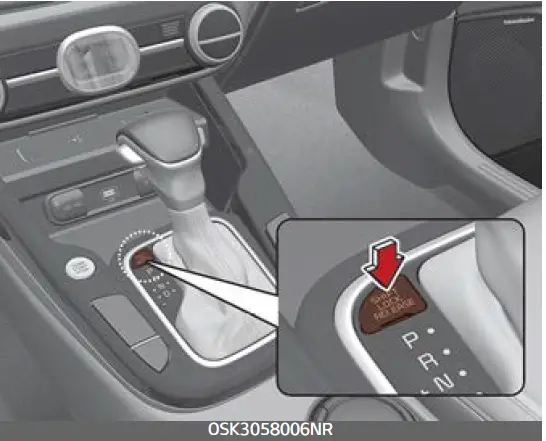
Type B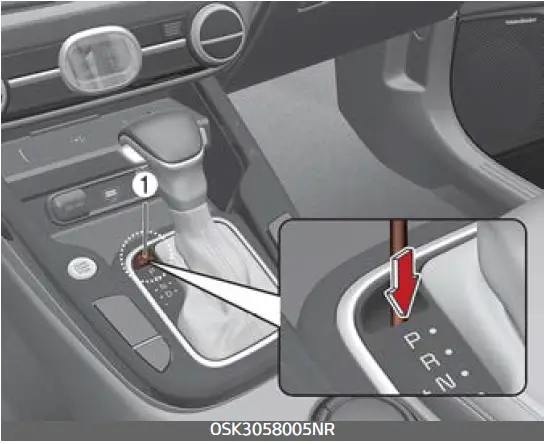
If the shift lever cannot be moved from the P (Park) position into R (Reverse) position with the brake pedal depressed, continue depressing the brake, then do the following:
- Place the ignition switch in the LOCK/OFF position.
- Apply the parking brake.
- Carefully remove the cap (1) covering the shift-lock release access hole.
- Insert a tool (e.g. flathead screw-driver) into the access hole and press down on the tool.
- Move the shift lever.
- Remove the tool from the shift-lock override access hole then install the cap.
- Have the system inspected by a professional workshop. Kia recommends to visit an authorized Kia dealer.
Ignition Key Interlock System
The ignition key cannot be removed unless the shift lever is in the P (Park) position.
Good Driving Practices
- Never move the shift lever from P (Park) or N (Neutral) to any other position with the accelerator pedal depressed.
- Never move the shift lever into P (Park) when the vehicle is in motion.
- Be sure the car is completely stopped before you attempt to shift into R (Reverse) or D (Drive).
- Never take the car out of gear and coast down a hill. This may be extremely hazardous. Always leave the car in gear when moving.
- Do not “ride” the brakes. This can cause them to overheat and malfunction. Instead, when you are driving down a long hill, slow down and shift to a lower gear. When you do this, engine braking will help slow the car.
- Slow down before shifting to a lower gear. Otherwise, the lower gear may not be engaged.
- Always use the parking brake. Do not depend on placing the transmission in P (Park) to keep the car from moving.
- Exercise extreme caution when driving on a slippery surface. Be especially careful when braking, accelerating or shifting gears. On a slippery surface, an abrupt change in vehicle speed can cause the drive wheels to lose traction and the vehicle to go out of control.
- Optimum vehicle performance and economy is obtained by smoothly depressing and releasing the accelerator pedal.
WARNING
- When driving uphill or downhill, always shift to D (Drive) for driving forward or shift to R (Reverse) for driving backward, and check the gear position indicated on the cluster before driving.
- Driving in the opposite direction of the selected gear can lead to a dangerous situation by shutting off the engine and affecting the braking performance.
- Always buckle-up! In a collision, an unbelted occupant is significantly more likely to be seriously injured or killed than a properly belted occupant.
- Avoid high speeds when cornering or turning.
- Do not make quick steering wheel movements, such as sharp lane changes or fast, sharp turns.
- The risk of rollover is greatly increased if you lose control of your vehicle at highway speeds.
- Loss of control often occurs if two or more wheels drop off the road-way and the driver oversteers to reenter the roadway.
- In the event, your vehicle leaves the roadway, do not steer sharply. Instead, slow down before pulling back into the travel lanes.
- Never exceed posted speed limits.
WARNING
If your vehicle becomes stuck in the snow, mud, sand, etc., then you may attempt to rock the vehicle free by moving it forward and backward. Do not attempt this procedure if people or objects are anywhere near the vehicle. During the rocking operation, the vehicle may suddenly move forward or backward as it becomes unstuck, causing injury or damage to nearby people or objects.
FAQs
- What is a dual-clutch transmission (DCT)?
A dual-clutch gearbox (DCT), commonly referred to as an advanced automatic gearbox, employs two distinct clutches for quick and seamless gear changes. - Is the Kia Soul 2023 equipped with a dual-clutch transmission?
A dual clutch gearbox is not an option for the Kia Soul 2023. It usually has a conventional automatic gearbox or a continuously variable gearbox (CVT). - What are the advantages of a dual-clutch transmission?
When compared to traditional automatic transmissions, a dual-clutch transmission has some benefits like quicker and smoother gear shifts, increased fuel efficiency, and higher performance. - Does the Kia Soul 2023 offer any transmission options?
Depending on the particular trim level and setup, the Kia Soul 2023 does indeed offer many gearbox options, such as a continuously variable gearbox (CVT) or a conventional automatic gearbox. - How many gears does the Kia Soul 2023 have?
The choice of transmission affects how many gears the Kia Soul 2023 has. The automatic gearbox may have a set number of gears, usually six or more, whereas the CVT normally offers an endless number of gear ratios. - Can I manually shift gears with a dual-clutch transmission?
Yes, dual clutch gearboxes frequently have manual shifting modes that let you move gears manually using the gear lever or paddle shifters. - Are dual clutch transmissions more expensive to maintain than other transmissions?
In general, compared to conventional automatic transmissions, dual clutch transmissions may need more specialized maintenance and may cost more to repair. The precise price, however, can change based on a number of variables, including the brand and type of the car. - Do dual clutch transmissions provide better fuel efficiency?
Dual clutch transmissions’ effective gear shifting system can help to increase fuel efficiency. However, a number of variables, such as the engine design, the weight of the vehicle, and the driving circumstances, affect a vehicle’s total fuel efficiency. - Can a dual clutch transmission be more responsive than a traditional automatic transmission?
It is true that twin clutch gearboxes are renowned for their swift and fluid gear changes, which can lead to a more responsive driving experience than conventional automatic transmissions. - Are dual clutch transmissions suitable for towing?
Dual clutch transmissions are capable of towing light weights, but they might not be as durable as some conventional automatic transmissions that are built for heavy-duty towing. It is crucial to review the towing recommendations and instructions provided by the manufacturer for your particular vehicle. - Can a dual clutch transmission be repaired if it develops a fault?
Yes, problems with dual clutch transmissions can be fixed. However, because of their intricate construction, it is advised to seek expert advice from authorized servicing facilities that are familiar with dual clutch transmissions. - Do dual clutch transmissions require a different type of transmission fluid?
The manufacturer may prescribe a particular brand of gearbox fluid for dual clutch gearboxes. To ensure peak performance and avert potential gearbox damage, the proper fluid must be used. - Can a dual clutch transmission be more engaging for sporty driving?
Due to their quick and precise gear changes, which can improve the overall driving experience and create a more engaging feel, dual clutch transmissions are frequently employed in sports cars and performance-oriented vehicles. - Are dual clutch transmissions suitable for off-road driving?
Dual clutch transmissions may be effective in some off-road situations, but they might not provide the same amount of low-speed crawling capability and torque multiplication as some specifically designed transmissions for off-road use. It’s crucial to think about the particular needs of your off-road activities and to review the manufacturer’s suggestions. - Are dual clutch transmissions reliable in the long term?
Although dual clutch transmissions have advanced over time, there is still some disagreement regarding their long-term dependability. Regular maintenance can help the gearbox last longer and reduce potential problems, such as fluid changes and adhering to the manufacturer’s instructions.
Useful Links
View Full User Guide: Kia Soul 2022 Owner’s Manual | Auto User Guide
Download Manuals: Owner’s Manuals and Documents | Kia

